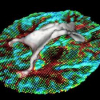Free Online Productivity Tools
i2Speak
i2Symbol
i2OCR
iTex2Img
iWeb2Print
iWeb2Shot
i2Type
iPdf2Split
iPdf2Merge
i2Bopomofo
i2Arabic
i2Style
i2Image
i2PDF
iLatex2Rtf
Sci2ools
ISBI
2006
IEEE
2006
IEEE
A statistical framework for DTI segmentation
We address the problem of the segmentation of cerebral white matter structures from diffusion tensor images (DTI). DTI can be estimated from a set of diffusion weighted images and provides tensorvalued images where each voxel is assigned with a 3 ? 3 symmetric, positive-definite matrix. As we will show in this paper, the definition of a dissimilarity measure and statistics between tensors is a non trivial task which must be carefully tackled. We claim that, by using the differential geometrical properties of the manifold of multivariate normal distributions, it is possible to improve the quality of the segmentation obtained with other dissimilarity measures such as the Euclidean distance or the Kullback-Leibler divergence. Our goal is to prove that the choice of this probability metric has a deep impact on the tensor statistics and, hence, on the achieved results. We introduce a variational formulation to estimate the optimal segmentation of a diffusion tensor image. We show how to es...
Diffusion Tensor Images | Diffusion Tensors Statistics | Diffusion Weighted Images | ISBI 2006 | Medical Imaging |
| Added | 20 Nov 2009 |
| Updated | 20 Nov 2009 |
| Type | Conference |
| Year | 2006 |
| Where | ISBI |
| Authors | Christophe Lenglet, Mikaël Rousson, Rachid Deriche |
Comments (0)

